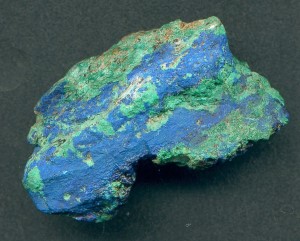
The copper ore »Sonora Sunrise« consists of the rust red copper(I)oxide cuprite, the black copper(II)oxide tenorite and the green copper sulfate brochantite, intergrown with chrysocolla.
Image: K. Sieber, www.makrogalerie.de
As with all substances in nature, the dose is crucial for the effect. Water consumed in excess is fatal. If you drink too little, you die of thirst. It is also comparable with the element copper. As a trace element, copper is a component of many enzymes and is therefore essential for life. The daily requirement of an adult human being is about 2 milligrams. Higher doses from 2-4 mg of copper per liter of water lead to symptoms of poisoning such as nausea, vomiting and diarrhea. Children are particularly at risk, as they are much more sensitive to copper overdoses than adults. Copper is mainly stored in the liver. Chronic poisoning causes damage to the liver and kidneys and can even lead to death in young children.
Some copper minerals are used as pesticides. The copper(I) oxide cuprite (Cu2O) is used for antifouling marine coatings because the dissolving copper kills algae and other aquatic organisms. The copper(II) oxychloride atacamite (Cu2Cl(OH)3), which often occurs in association with chrysocolla, is used in agriculture as a plant protection agent (fungicide). Both minerals are harmful to humans when swallowed and when dust is inhaled.
Copper minerals are very toxic to aquatic organisms. They can cause long-term adverse effects in water. Water-insoluble copper minerals in powder form are also considered to be highly hazardous to water and must not be allowed to enter groundwater or sewage systems, even in small quantities.
Chalkanthite
Das leuchtendblaue Kupfersulfat Chalkanthit (CuSO4 · 5 H2O) wird im Mineralienhandel oft in Form großer, künstlich gezüchteter Kristalle angeboten. Es ist sehr gut wasserlöslich (316 g/l) und ein starkes Brechmittel. Möglicherweise ist es auch krebserregend oder -fördernd. An der Luft zerfällt es langsam unter Wasserabgabe zu blassen, lockeren, pulvrigen Überzügen und Stäuben. Um einer Zersetzung entgegenzuwirken, sollte Chalkanthit in einem luftdicht verschlossenen Behälter aufbewahrt werden.
Azurite & Malachite

natural azurite malachite
Unlike chalcanthite, the copper(II) hydroxide carbonates azurite (Cu3(CO3)2(OH)2) und malachite (Cu3(CO3)2(OH)2) are insoluble in water. Unfortunately, they dissolve very well in acids, which includes stomach acid. The two minerals unfold their danger potential if they are swallowed by mistake, for example. This is unlikely to happen to an adult. Children, on the other hand, like to put objects like small polished tumbled stones in their mouths. In doing so, a stone could be swallowed accidentally. Decomposition in the stomach releases large amounts of copper ions, which can lead to nausea, vomiting and diarrhea. Since children are much more sensitive to copper overdoses than adults, azurite and malachite should be kept out of children's hands.
Due to the harmful dust and environmentally damaging grinding water, azurite and malachite may no longer be processed in Europe.
Native elemental copper
Native elemental copper is physiologically harmless and is classified as non-toxic. In the normal handling of a mineral collector with elemental copper poisoning is excluded.
read more on this topic:




